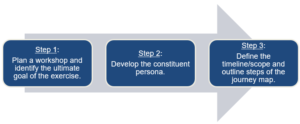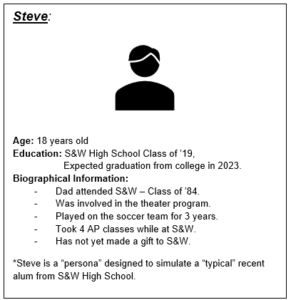

What is Journey Mapping?
Journey mapping is an exercise of visualizing the chronology of touchpoints that a constituent has with your organization. The origins of the “journey” concept are often attributed to the for-profit sector (Williams, 2015); however, in recent years the practice has become increasingly common among nonprofit organizations to inform their programmatic and development strategies. Fundraisers may find it useful to create journey maps for each of the constituency types that are directly relevant to their work (e.g. prospects, donors, Board members, institutional funders).
While a simple exercise, journey mapping both promotes intentionality and challenges assumptions of development professionals in their efforts to craft an effective donor experience. A journey map should be based on the current realities of your constituents and can be utilized to support an established goal or to identify and/or address a specific issue. The process fosters a deeper understanding of the thoughts and feelings of particular types of constituents as they interact with your organization.
What Are the Benefits Journey Mapping?
Journey mapping can elucidate specifically where, when and how constituents interact with your organization. The exercise allows you to visualize the arrangement of multi-channel touchpoints at the individual level – including personal outreach, email and social media interactions.
Journey mapping may either challenge or affirm whether the constituent journey follows a logical path. It often deepens insights into constituent behaviors reflected through quantitative data analysis, exposes organizational siloes, and reveals disconnects between the desired constituent experience and the one constituents receive. Above all, crafting a journey map will prompt you to concentrate your efforts and investments on the areas that will maximize your development outcomes (Salesforce UK, 2016; Kaplan, 2016). Moreover, the process may generate creative strategies for further segmenting and personalizing your interactions with different groups of individuals.
While journey mapping is still relatively new in the nonprofit world, research on the practice in the for-profit sector underscores its benefits and reflects significant implications for nonprofit organizations. In its 2016 report Customer Journey Mapping: Lead The Way To Advocacy, the Aberdeen Group found that companies with a formal journey mapping program experienced significantly better year-over-year business outcomes than their counterparts, including greater return on marketing investment, improvement in customer service costs and increased revenue from customer referrals.
How to Create a Journey Map

Step 1: Plan a workshop and identify the ultimate goal of the exercise.
The journey mapping process is ideally conducted in an internal workshop format with a diverse cross-section of staff and volunteer leadership participation. All departments should have a seat at the table in order to most effectively uncover organizational siloes, offer unique perspectives and further cultivate a culture of philanthropy where all stakeholders understand their role in the fundraising process.
For journey mapping to be most effective, it is best to identify a specific outcome for the exercise. For example, S&W High School (fictionalized for the purpose of this article) has an established goal of increasing first-time donations from recent graduates.
The Nielsen Norman Group, a thought leader in the consumer journey mapping process, emphasizes the importance of utilizing real and valid data whenever possible (Kaplan, 2016). For the example above, S&W High School should evaluate key metrics such as the current number of alumni who donate within their first year after graduation, when they are donating and through which channels they are donating. While a journey map inevitably requires making some assumptions, utilizing real data whenever possible will ground the map in reality and make it more practical.
Step 2: Develop the constituent persona.
The persona developed for a journey should be intentionally representative of the average individual constituent of the group you are mapping. Biographical data on constituents can also be applied at this point to make the persona as realistic as possible. Depending on the goal and scope of the map, the persona can be more or less detailed. Steve is an example of recent graduate prospect persona for S&W High School.

Step 3: Define the timeline/scope and outline steps of the journey map.
A journey map can be as granular or as broad as necessary for the situation you are aiming to explore. Determining the scope of the map will help to focus your efforts on the most important touchpoints between the constituent and your organization. It is often helpful to start by determining the critical step in the journey at hand that reflects your desired goal. In Steve’s example, this step will be his first donation made to S&W High School after graduation. Next, consider what happens before and after that step in order to craft a journey that will maximize your potential to achieve desired results (YouTube, 2019).
Perhaps S&W discovered that Steve needed more in-person touchpoints following graduation in order to increase his likelihood of giving within the first year after graduating. S&W High School may consequently plan for more creative opportunities to engage Steve in person while he is home on vacation from college.
Considerations for Effective Journey Mapping
Journey mapping is a productive exercise for an organization to better understand the constituent experience. While traditional nonprofit fundraising often aims to guide a donor through a predetermined cycle of activities in order to meet a desired outcome, journey mapping is an intentionally constituent-centered process: it focuses on the individual and builds the appropriate experience around them (Workman, 2017). Engaging in a process of “walking in their shoes” can yield valuable insights that can have a lasting impact on your development operation.
If you would like to do a journey map at your organization, there are many free or low-cost journey mapping tools available online to help you get started. Smaply offers many informative resources and user-friendly mapping tools for interested organizations (*Schultz & Williams was not paid to promote this service).
Bibliography
Aberdeen Group (2016) Customer Journey Mapping: Lead The Way To Advocacy. MCorpCx (Website). Accessed June 9, 2019. https://www.mcorpcx.com/customer-journey-mapping-lead-the-way-to-advocacy-lp
Goddard, P. & Hoski, K. 5 Essential Components of Effective Customer Journey Maps. Tandemseven (Website). Accessed June 9, 2019. https://www.tandemseven.com/journey-mapping/5-essentials-for-customer-journey-maps/
Kaplan, K. (2016) When and How to Create Customer Journey Maps. Nielsen Norman Group (Website). Accessed June 9, 2019. https://www.nngroup.com/articles/customer-journey-mapping/
McWilliams, C. (2018) Donor Journeys: Put a Plan in Motion. NonProfitPro (Website). Accessed June 9, 2019. https://www.nonprofitpro.com/post/donor-journeys-put-a-plan-in-motion/
YouTube (website). “How to Create a Journey Map.” Smaply. Accessed June 12, 2019. https://www.youtube.com/watch?v=A2LFJF1SUBg
Williams, I. (2015) Customer Journey Mapping – An Art or a Science? Part 1. CustomerThink (Website). Accessed June 9, 2019. http://customerthink.com/customer-journey-mapping-an-art-or-a-science-part-1/
Workman, J. (2017) Creating Donor Journeys to Improve Fundraising. Salesforce (Website). Accessed June 9, 2019. https://www.salesforce.org/creating-donor-journeys-improve-fundraising/


